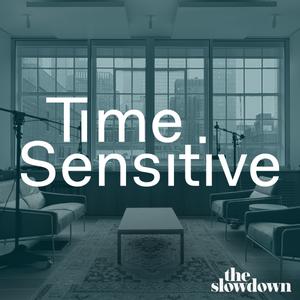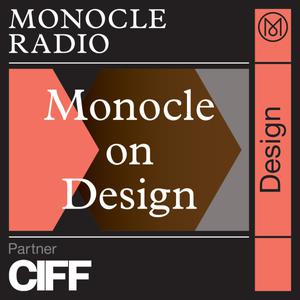
Time Sensitive Podcast
The Slowdown
Time Sensitive is a podcast that features candid, revealing portraits of curious and courageous people in business, the arts, and beyond who have a distinct perspective on time. Co-hosts Spencer Bailey and Andrew Zuckerman respectively interview a leading mind who has made a profound impact in their field, contributed to the larger conversation, and is concerned with the planet we all share.
- 1 hour 12 minutesMalcolm Gladwell on Finding Freedom in Abandoning Expectations
Malcolm Gladwell may be one of the most widely read—and, with his Revisionist History podcast, listened to—journalists of our time. A New Yorker magazine staff writer and the author of seven New York Times bestsellers, including The Tipping Point (2000), Blink (2005), and Outliers (2008), he has myriad awards and honors to his name. But this impressive trajectory has never been some planned-out or preordained journey; in fact, as Gladwell says on this episode of Time Sensitive, he has never been one to try to overly plan for or divine the future—of his career, of his life, or of anything, really. “Expectations are a burden and wherever possible should be abandoned,” he says. Gladwell’s radical receptiveness is perhaps what has led him to become one of today’s most prolific and eclectic writers, reporting on topics ranging from office design and french fries, to dog fighting and Steve Jobs, to automobile engineers and marijuana. Across all of his writing, Gladwell exhibits a rare sleight-of-hand ability to take certain intellectual or academic subjects and leap-frog them into popular culture, and, in doing so, make seemingly esoteric phenomena entertaining and widely accessible.
On the episode—recorded in the Pushkin Industries outpost in Hudson, New York—Gladwell talks about the disappearance of what he calls “the critical enterprise in America”; and how A.I. is complicating his famous “10,000-Hour Rule.”
Special thanks to our Season 10 presenting sponsor, L’École, School of Jewelry Arts.
Show notes:
[4:36] Revenge of the Tipping Point
[5:06] The Tipping Point
[13:43] Unsafe at Any Speed
[22:52] Anand Giridharadas
[24:00] Revisionist History
[25:39] Blink
[31:07] The Holocaust in American Life
[43:16] “10,000-Hour Rule”
[43:16] Outliers
[56:06] The Bomber Mafia (Podcast Mini Series)
[56:06] Pushkin Industries
[59:56] John Grisham
[1:06:56] The Bomber Mafia (Book)
18 December 2024, 5:00 am - 1 hour 1 minuteRichard Christiansen on Bridging Horticulture and Popular Culture
Richard Christiansen believes that the true definition of luxury is having one’s senses on full blast—seeing, tasting, smelling, hearing, and touching the world around by engaging in its beauty and bounty to the fullest. This idea is at the heart of his company, the garden-pleasure apothecary Flamingo Estate, which is both a place—a home and garden on a seven-acre property in the hills of Los Angeles—and a brand, which operates a global farming collective and sells wellness, beauty, and “home essentials” products. In just a few years, Flamingo Estate has collaborated with cultural figures such as Julianne Moore, Martha Stewart, and Ai Weiwei, and created some 200 or so products, from C.S.A.-style farm boxes and flower arrangements, to scented candles and a rosé wine, to body washes and chocolates. Capturing the spirit of all this is a new book, Flamingo Estate: The Guide to Becoming Alive, which tells the story of his company’s rapid rise and includes interviews with the likes of Jane Fonda, John Legend, and Alice Waters.
On the episode, Christiansen talks about his lifelong connection with beekeeping and honey; why more brands should embrace “radical inconsistency” in their products; and how reading a book by Jane Goodall, and later befriending the anthropologist and conservationist, changed the course of his life.
Special thanks to our Season 10 presenting sponsor, L’École, School of Jewelry Arts.
Show notes:
[4:24] Flamingo Estate
[8:05] Flamingo Estate: The Guide to Becoming Alive
[46:21] Jane Goodall
[12:48] Alice Waters
[15:06] Harvey
[35:35] Chandelier Creative
[45:51] Benetton
[45:51] Colors
[50:35] Rumiko Murata
[52:35] Owl Bureau
[58:28] “The Summer Day”
11 December 2024, 5:00 am - 58 minutes 45 secondsMarcia Bjornerud on the Profound Wisdom of Rocks
To the majority of humankind, rocks may appear to be static, timeless objects, but not to the geologist Marcia Bjornerud. In her mind, rocks are rich pieces of text that have evolved (and continue to evolve) across millennia, and are therefore incredibly timeful. “They almost demand reading,” Bjornerud says on this episode of Time Sensitive. “You have the feeling that you’re communicating with some larger, wilder, more ancient wisdom.” A two-time Senior Fulbright Scholar, a professor of geology at Lawrence University in Wisconsin, and an expert on the geophysics of earthquakes and mountain building, Bjornerud serves as a sort of geological translator of these “texts,” reading their encrypted messages and stories—tracing their etymologies, essentially—and from there inferring why things are the way they are. Bjornerud’s translations shine across her four books, including the newly published Turning to Stone: Discovering the Subtle Wisdom of Rocks.
On the episode, she discusses the power of looking at the world through a Deep Time lens, why we’re currently in what she considers a “golden age” of geoscience, and what a “time literate” society would mean for humanity and the planet.
Special thanks to our Season 10 presenting sponsor, L’École, School of Jewelry Arts.
Show notes:
[15:18] Timefulness: How Thinking Like a Geologist Can Help Save the World
[07:16] Turning to Stone: Discovering the Subtle Wisdom of Rocks
[07:16] “Studying Stones Can Rock Your World”
[07:16] Geopedia: A Brief Compendium of Geologic Curiosities
[07:16] Carbon cycle
[09:47] Rock deformation
[13:54] The overview effect
[17:42] “Geology Is Like Augmented Reality for the Planet”
[21:28] Colonization of Mars
[21:28] Anthropocene
[29:06] Planned obsolescence
[29:06] Green technology revolution
[31:40] Seventh Generation Principle
[34:01] Stonehenge
[38:29] University of Minnesota
[41:02] Svalbard, Norway
[41:02] Norwegian Polar Institute
[44:15] Yoshihide Ohta
[50:06] “Lost Time in Amatrice”
[54:19] Kola Superdeep Borehole
20 November 2024, 5:00 am - 54 minutes 5 secondsNachson Mimran on Leveraging Privilege for Good and in Service of Others
With great privilege, believes the humanitarian and entrepreneur Nachson Mimran, comes great responsibility. Brought up in a family that operates one of the largest agri-industrial businesses in West Africa, Mimran comes from considerable wealth, but unlike so many who have a background such as his, he is open and forthright about his inheritance and the responsibility he sees of doing good with it. With his decarbonization, refugee empowerment, and “human optimization” organization to.org, he’s creating deep impact through various design and development projects in refugee settlements—including the Bidi Bidi Performing Arts Center, completed last year in Uganda—and empowering individuals and communities via what he describes as “venture philanthropy.” At The Alpina Gstaad hotel in the Swiss Alps, which he’s the co-founder of, he provides exceptional hospitality experiences that subvert certain traditional industry codes, fostering a relaxed but elevated environment.
On the episode, recorded in front of a live audience at The Lobby “hospitality event” in Copenhagen earlier this fall, Mimran discusses his big-picture view of the word hospitality; how a family tragedy led him and his brother to found to.org; and his bold vision for building transformative spaces for refugees.
Special thanks to our Season 10 presenting sponsor, L’École, School of Jewelry Arts.
Show notes:
[00:44] The Lobby
[03:46] to.org
[09:37] The Alpina Gstaad
[09:37] Jean Claude Mimran
[11:00] Marcel Bach
[13:47] Arieh Mimran
[19:29] Pangaia
[23:28] Regenerate
[23:28] Kakuma Refugee Settlement
[23:28] Sumayya Vally
[26:04] Hassell
[26:04] Xavier De Kestelier
[27:06] Bidi Bidi Performing Arts Centre
[27:06] Bidi Bidi Refugee Settlement
[27:49] Mike Zuckerman
[27:49] Nakivale Refugee Settlement
[32:11] The Throne
[38:16] Kutupalong Refugee Settlement
[48:09] André Balazs
13 November 2024, 5:00 am - 1 hour 12 minutesJonathan Lethem on Novel Writing as a Memory Art
Perhaps best known for his novels Motherless Brooklyn (1999), The Fortress of Solitude (2003), and Chronic City (2009)—or, more recently, Brooklyn Crime Novel (2023)—the author, essayist, and cultural critic Jonathan Lethem could be considered the ultimate modern-day Brooklyn bard, even if today he lives in California, where he’s a professor of English and creative writing at Pomona College. His most celebrated books take place in Brooklyn, or in the case of Chronic City, on Manhattan’s Upper East Side, and across his genre-spanning works of fiction, his narratives capture a profound sense of the rich chaos and wonder to be found in an urban existence. Lethem is also the author of several essay collections, including the newly published Cellophane Bricks: A Life in Visual Culture (ZE Books), which compiles much of his art writing from over the years written in response to—and often in exchange for—artworks by friends, including Gregory Crewdson, Nan Goldin, and Raymond Pettibon.
On the episode, Lethem discusses his passion for book dedications; the time he spent with James Brown and Bob Dylan, respectively, when profiling them for Rolling Stone in the mid-aughts; how his work is, in part, a way of dealing with and healing from his mother’s death in 1978, at age 36; and why he views his writing as “fundamentally commemorative.”
Special thanks to our Season 10 presenting sponsor, L’École, School of Jewelry Arts.
Show notes:
[5:35] Cellophane Bricks
[5:35] High School of Music and Art
[5:35] Motherless Brooklyn
[5:35] The Fortress of Solitude
[5:35] The Disappointment Artist
[7:15] Carmen Fariña
[9:08] The Great Gatsby
[9:08] Brooklyn Crime Novel
[10:59] Lynn Nottage
[13:08] Bennington College
[23:41] The Collapsing Frontier
[23:41] Italo Calvino
[27:37] Dada movement
[27:37] Dissident Gardens
[31:21] Nan Goldin
[34:33] “The Ecstasy of Influence”
[42:32] “Being James Brown: Inside the Private World of the Baddest Man Who Ever Lived”
[42:32] “The Genius and Modern Times of Bob Dylan”
[51:00] Chronic City
[1:06:26] Jorge Luis Borges
30 October 2024, 4:00 am - 1 hour 1 secondLindsey Adelman on the Transformative Nature of Light
To the lighting designer Lindsey Adelman, light is at once ubiquitous and precious, quotidian yet miraculous; it can be easily overlooked or taken for granted, but it also has the potential to become transformative or even otherworldly. Through her craft-forward approach, Adelman creates pieces that defy strict labels and explore the tensions between organic and industrial forms and materials, combining hand-blown glass with industrial and machine-milled components. Since launching her eponymous company in 2006, she has built a formidable business, perhaps becoming best known for her Branching Bubble chandeliers, a series that consists of glass “bubbles” elegantly mounted on the ends of brass, bronze, or nickel “branches.” Adelman also runs an experimental space called LaLAB as a means of exploring and meditating on illumination through the creation of one-off and limited-edition pieces, as well as private commissions.
On the episode, she discusses her recent decision to shift her company away from a large-scale production operation and toward a smaller, more intimate “studio” model; the great surprise of having one of her designs installed in Vice President Kamala Harris’s Washington, D.C., home; and her love of hosting.
Special thanks to our Season 10 presenting sponsor, L’École, School of Jewelry Arts.
Show notes:
[6:05] Ingo Maurer
[6:05] Gaetano Pesce
[7:55] Burst Chandelier
[12:22] “A Realm of Light”
[14:55] Isamu Noguchi’s Akari light sculptures
[17:20] Yosemite National Park
[18:41] James Turrell
[18:41] House of Light
[20:47] Noguchi’s “Lunar Infant”
[24:40] Writings by Agnes Martin
[26:52] Hiroshi Sugimoto
[27:46] David Lynch
[29:08] “Paul McCarthy: WS”
[29:08] Matthew Barney
[30:54] Haruki Murakami
[33:14] “A Cacao Ceremony That Brought Close Friends Even Closer”
[48:13] Branching Bubble chandelier
[48:13] Buckminster Fuller
[52:01] Adelman’s open-source D.I.Y. light project
[52:30] David Weeks
[52:30] Lunette
[52:46] “The Lighting Designer From Everyone’s Dream Brooklyn Brownstone”
[52:46] Rich People Problems
[52:46] Gwyneth Paltrow
23 October 2024, 4:00 am - 1 hour 12 minutesPaul Goldberger on Architecture as an Act of Optimism
In the eyes of the architecture critic Paul Goldberger, a building is a living, breathing thing, a structure that can have a spirit and even, at its best, a soul. It’s this optimistic perspective that has given Goldberger’s writing a certain ineffable, captivating quality across his prolific career—first at The New York Times, where he served as the paper’s longtime architecture critic, winning a Pulitzer Prize in 1984; then as the architecture critic at The New Yorker from 1997 to 2011; and now, as a contributing editor at Vanity Fair. Goldberger is the author of several books, including Building Art: The Life and Work of Frank Gehry (2015), Why Architecture Matters (2009), and Building Up and Tearing Down: Reflections on the Age of Architecture (2009). He is also the chair of the advisory board of the Glass House in New Canaan, Connecticut, where we recorded this episode, our third “site-specific” interview on Time Sensitive.
On the episode, Goldberger discusses the Glass House’s staying power as it turns 75, the evolution of architecture over the past century, what he’s learned from writing architects’ obituaries, and the Oreo cookie from a design perspective.
Special thanks to our Season 10 presenting sponsor, L’École, School of Jewelry Arts.
Show notes:
[05:17] Glass House
[05:17] Philip Johnson
[07:06] Ludwig Mies van der Rohe
[07:06] Farnsworth House
[08:42] Brick House
[12:37] Gordon Bunshaft
[12:37] Lever House
[12:37] Frank Lloyd Wright
[12:37] Guggenheim Museum
[13:18] TWA Flight Center
[13:18] Kevin Roche
[13:18] Ford Foundation building
[13:18] CBS Building
[15:17] Noyes House
[16:17] U.N. Headquarters
[17:50] Centre Pompidou
[17:50] I.M. Pei
[17:50] Louvre Pyramid
[17:50] Frank Gehry
[17:50] Guggenheim Bilbao
[20:00] Walt Disney Concert Hall
[23:20] Stuyvesant Town
[24:24] “Oreo, at 75, the World’s Favorite Cookie; Machine Imagery, Homey Decoration”
[25:46] “Quick! Before It Crumbles!: An architecture critic looks at cookie architecture”
[25:46] Nora Ephron
[26:18] “Design Notebook; Commonplace Things Can Be Great Designs”
[27:16] Bauhaus
[29:10] Fallingwater
[29:10] Richard Neutra
[29:10] Lovell House
[29:10] Gehry House
[29:10] Louis Kahn
[32:38] “Philip Johnson, Architecture’s Restless Intellect, Dies at 98”
[32:38] “Louis I. Kahn Dies; Architect Was 73”
[35:30] Paul Rudolph
[36:50] Zaha Hadid
[37:22] “New Police Building”
[38:19] Henry Geldzahler
[41:31] Why Architecture Matters
[43:21] Chrysler Building
[47:28] Vincent Scully
[48:18] Lewis Mumford
[1:00:47] The City Observed: A Guide to the Architecture of Manhattan
[1:00:47] World Trade Center
[1:02:49] “Here Is New York” by E.B. White
[1:05:33] Design: The Leading Hotels of the World
[1:07:25] Ritz Paris
[1:07:25] The Dylan Amsterdam
[1:09:01] “Why Buildings Grow On Us”
9 October 2024, 4:00 am - 59 minutesFrancesco Clemente on Painting as Poetry and Performance
The artist Francesco Clemente may have been born and raised in Naples, but—having lived and worked around the world, including in Rome, India, New York City, and New Mexico—he considers himself a citizen of no place. Widely known for his work across mediums, from drawings and frescoes to mosaics, oils, and sculptures, Clemente makes art that evokes his mystical perspective, with his paintings often featuring spiritual subjects or dreamlike symbols. Beyond exhibiting in galleries and museums, over the years Clemente has also made works for a variety of other venues, including a nightclub, a hotel, a Hollywood film, and the Metropolitan Opera. This fall, his work (and name) will be central to his latest unusual project: the soon-to-open Clemente Bar at chef Daniel Humm’s three-Michelin-starred restaurant Eleven Madison Park.
On the episode, Clemente discusses his collaboration with Humm, frescoes as the most luminous artistic medium, his deep affinity with India, and the certain timeworn quality to his art.
Special thanks to our Season 10 presenting sponsor, L’École, School of Jewelry Arts.
Show notes:
[3:55] Clemente Bar
[3:55] Eleven Madison Park
[3:55] Daniel Humm
[3:55] Alba Clemente
[7:50] Murals for the Palladium nightclub
[7:50] Hudson Hotel
[7:50] Ian Schrager
[8:43] Arata Isozaki
[8:43] Philippe Starck
[8:43] Kenny Scharf
[8:43] Keith Haring
[8:43] Jean-Michel Basquiat
[8:43] Steve Rubell
[9:43] Works for Great Expectations (1998)
[9:43] “The Sopranos” series
[9:43] Portrait of Fran Lebowitz
[11:37] Portrait of Toni Morrison
[23:12] Jiddu Krishnamurti
[23:12] Theosophical Society
[24:49] Álvaro Siza
[24:49] Museo Madre
[32:48] Cy Twombly
[32:48] Joseph Beuys’s exhibition “We Are the Revolution” (1972)
[35:30] Rudolf Steiner
[36:56] Letters to a Young Poet by Rainer Maria Rilke
[37:57] Swami Vivekananda
[39:20] Salman Rushdie
[41:31] Nisargadatta Maharaj
[46:51] Andy Warhol
[46:51] Allen Ginsberg
[48:13] William Blake
[48:54] Raymond Foye
[48:54] Hanuman Books
[50:04] “The Four Corners” (1985)
[53:36] Saint Francis
25 September 2024, 4:00 am - 1 hour 3 minutesSarah Lewis on “Aesthetic Force” as a Path Toward Justice
In her new book, The Unseen Truth: When Race Changed Sight in America (Harvard University Press), the historian and Harvard professor Sarah Lewis unpacks a major part of United States history that until now wasn’t just brushed over, but was intentionally buried: how the Caucasian War and the end of the Civil War were conflated by P.T. Barnum, former President Woodrow Wilson, and others to shape how we see race in America. Long overdue, The Unseen Truth is a watershed book about photography and visuality that calls to mind works by history-shaping authors such as James Baldwin, Toni Morrison, and bell hooks. Lewis is also the founder of the Vision & Justice initiative, which strives to educate the public about the importance of art and culture for equity and justice in the U.S., and is launching a new publishing venture with Aperture this fall.
On the episode, she discusses the tension between pedagogy and propaganda; the deep influence of Frederick Douglass’s 1861 “Pictures and Progress” lecture on her work; how a near-death car crash altered the course of her life and The Unseen Truth; and the special ability of certain photographs to stop time.
Special thanks to our Season 10 presenting sponsor, L’École, School of Jewelry Arts.
Show notes:
[04:01] The Unseen Truth
[05:24] Woodrow Wilson
[05:24] Frederick Douglass
[05:24] P.T. Barnum
[06:51] Toni Morrison
[06:51] Angela Davis
[06:51] Mathew Brady
[51:14] Vision & Justice
[11:35] Caucasus
[14:02] Imam Shamil
[17:38] Caucasian War
[19:31] MFA Boston
[19:31] The Metropolitan Museum
[22:30] “Pictures and Progress”
[28:41] “A Circassian”
[28:41] “Slave Ship”
[28:41] “The Gulf Stream”
[35:13] Frances Benjamin Johnston
[39:20] Jarvis Givens
[39:20] Fugitive Pedagogy
[44:05] The Rise: Creativity, the Gift of Failure, and the Search of Mastery
[49:08] Montserrat
[49:08] Under the Volcano
[51:36] Aperture
[52:26] Maurice Berger
[52:26] Coreen Simpson
[52:26] Doug Harris
[52:26] Deborah Willis
[52:26] Leigh Raiford
[52:57] Hal Foster
[56:01] Hank Willis Thomas
[56:01] Theaster Gates
[56:01] Mark Bradford
[56:01] Amy Sherald
[57:58] Wynton Marsalis
[57:58] Charles Black, Jr.
[57:58] Louis Armstrong
[57:58] Brown v. Board of Education
18 September 2024, 4:00 am - 58 minutes 11 secondsRita Sodi on Food as a Reflection of Home
For Rita Sodi, cooking isn’t so much an art or a science, but rather an intuitive way for her to channel her Tuscan roots and provide a profound sense of home. Following a 15-year career in the world of fashion as a self-described “denim guru” for Calvin Klein Jeans, Sodi transitioned into the realm of restaurants in 2008, when she moved to New York City from Bagno a Ripoli, Italy, and opened the West Village establishment I Sodi. Soon after, Sodi serendipitously met her life and work partner, Jody Williams—the chef-owner of the French bistro Buvette—and the two went on to found the restaurant group Officina 1397. Now, in addition to I Sodi and Buvette, they also operate Via Carota, The Commerce Inn, and Bar Pisellino. Across all of Sodi’s undertakings, her motive is clear: to create dishes she loves with great care and rigor, and, at least in the cases of I Sodi and Via Carota, to share an abiding passion for Tuscan cooking.
On the episode, Sodi discusses learning to cook from her mother, her atypical journey from fashion to food, and some of the stringent rules she follows in the kitchen and in life.
Special thanks to our Season 10 presenting sponsor, L’École, School of Jewelry Arts.
Show notes:
[25:50] Tuscany
[4:50] West Village
[5:58] I Sodi
[6:47] Calvin Klein Jeans
[8:31] Jody Williams
[8:31] Via Carota
[8:31] Officina 1397
[8:31] Bar Pisellino
[8:31] The Commerce Inn
[8:31] Buvette
[20:29] Pete Wells
[23:22] “An Ode to I Sodi”
[23:22] “The 100 Best Restaurants in New York City 2024”
[23:22] “When I Want to Be Alone, I Eat Dinner at the Bar at I Sodi”
[25:50] Bagno a Ripoli
[29:35] “The Laws of Tuscan Eating at I Sodi in the West Village”
[48:26] Emilia-Romagna
[53:53] Jeff Gordinier
4 September 2024, 4:00 am - 1 hour 9 minutesEdwina von Gal on Gardening as an Antidote
To the landscape designer Edwina von Gal, gardening is much more than just seeding, planting, weeding, and watering; it’s her life calling. Since starting her namesake firm in 1984 in East Hampton, on New York’s Long Island, she has worked with, for, and/or alongside the likes of Calvin Klein, Larry Gagosian, Frank Gehry, Maya Lin, Annabelle Selldorf, Richard Serra, and Cindy Sherman, creating gardens that center on native species and engage in other nature-based land-care solutions. In 2008, von Gal founded the Azuero Earth Project in Panama to promote chemical-free reforestation with native trees on the Azuero Peninsula. Stemming out of this initiative, in 2013, she then founded the Perfect Earth Project to promote chemical-free, non-agricultural land management in the U.S. Her most recent effort, Two Thirds for the Birds, is a call-to-action to plant more native plants and eliminate pesticides, thus creating a greater food supply for birds.
On the episode, she discusses the meditative qualities of gardening; reframing landscaping as “land care”; and why she sees herself not as a steward of land, but rather as a collaborator with it.
Special thanks to our Season 9 presenting sponsor, L’École, School of Jewelry Arts.
Show notes:
[15:32] William Cronon
[15:32] Changes in the Land
[15:32] Tiokasin Ghosthorse
[24:04] Carl Sagan
[24:04] The Demon-Haunted World
[26:07] Perfect Earth Project
[40:37] Two Thirds for the Birds
[42:41] John Fitzpatrick
[42:41] Cornell Lab of Ornithology
[42:41] Merlin Bird ID
[47:01] Garden Club of America
[50:21] Diana Vreeland
[51:09] Peter Sharp
[51:09] Channel Gardens at Rockefeller Center
[54:46] Frank Gehry
[54:46] Biomuseo
[54:46] Bruce Mau
[56:32] Azuero Earth Project
[1:00:37] Doug Tallamy
[1:02:01] Nature’s Best Hope
[1:05:12] The High Line
[1:05:12] Brooklyn Bridge Park
[1:05:12] The Battery Conservancy
[1:05:12] Brooklyn Museum
26 June 2024, 4:00 am - More Episodes? Get the App
Your feedback is valuable to us. Should you encounter any bugs, glitches, lack of functionality or other problems, please email us on [email protected] or join Moon.FM Telegram Group where you can talk directly to the dev team who are happy to answer any queries.
 Clever
Clever
 About Buildings + Cities
About Buildings + Cities
 The Great Women Artists
The Great Women Artists
 Homing In
Homing In
 Design Matters with Debbie Millman
Design Matters with Debbie Millman
 Monocle on Design
Monocle on Design